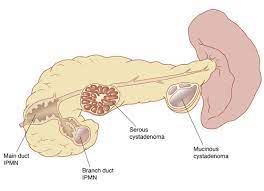1.Acute pancreatitis
Acute pancreatitis means inflammation of the pancreas that develops quickly. The main symptom is tummy (abdominal) pain. It usually settles in a few days but sometimes it becomes severe and very serious. The most common causes of acute pancreatitis are gallstones and drinking a lot of alcohol.
Symptoms of acute pancreatitis
- Being sick (vomiting), a high temperature (fever) and generally feeling very unwell are common.
- Your abdomen may become swollen.
- If the pancreatitis becomes severe and other organs become involved (for example, your heart, lungs or kidneys) then various other symptoms may develop. You may become lacking in fluid in the body (dehydrated) and have low blood pressure.

2.Chronic pancreatitis
Chronic pancreatitis can lead to permanent scarring and damage. Calcium stones and cysts may develop in your pancreas, which can block the duct, or tube, that carries digestive enzymes and juices to your stomach. The blockage may lower the levels of pancreatic enzymes and hormones, which will make it harder for your body to digest food and regulate your blood sugar. This can cause serious health problems, including malnutrition and diabetes.
Symptoms of Chronic Pancreatitis ?
At first, you may not notice any symptoms. Changes in your pancreas can become quite advanced before you begin to feel unwell. When symptoms occur, they may include:
- pain in your upper abdomen
- diarrhea
- fatty stools, which are loose, pale, and don’t flush away easily
- nausea and vomiting
- shortness of breath
- unexplained weight loss
- excessive thirst and fatigue

3.Pancreatic pseudocysts
Pancreatic pseudocysts are collections of leaked pancreatic fluids. They may form next to the pancreas during pancreatitis.The pancreas is an organ that sits behind your stomach. It makes fluids that flow through a duct into the small intestine. These fluids help you digest food. The pancreas also releases hormones to help control blood sugar. This includes insulin. The cause of these conditions and treatments may vary. Also some true cysts are cancer. But pancreatic pseudocysts never are.
symptoms pancreatic pseudocysts ?
- Pancreas trauma
- Pancreas infection
- Pancreatic tumor
- High calcium levels in your blood
- Very high levels of blood fats (cholesterol)
- Pancreatic damage from medicines
- Autoimmune diseases

4.pancreas tumours (cancer)
pancreas tumours (cancer)an organ in your abdomen that lies behind the lower part of your stomach. Your pancreas releases enzymes that aid digestion and produces hormones that help manage your blood sugar.
Several types of growths can occur in the pancreas, including cancerous and noncancerous tumors. The most common type of cancer that forms in the pancreas begins in the cells that line the ducts that carry digestive enzymes out of the pancreas (pancreatic ductal adenocarcinoma).
- Jaundice and related symptoms. Jaundice is yellowing of the eyes and skin.
- Belly or back pain. Pain in the abdomen (belly) or back is common in pancreatic cancer.
- Weight loss and poor appetite. .
- Nausea and vomiting.
- Gallbladder or liver enlargement.
- Blood clots.


